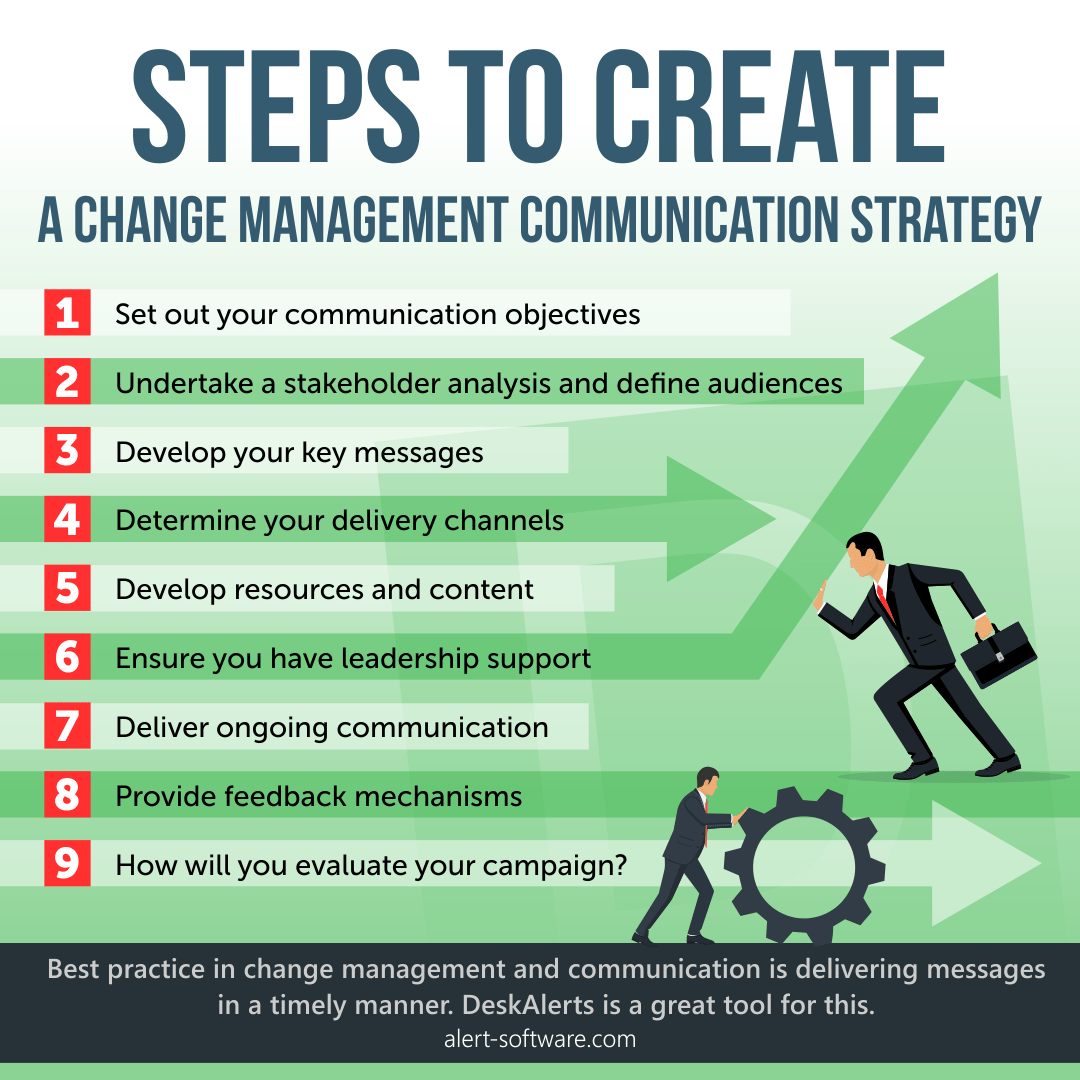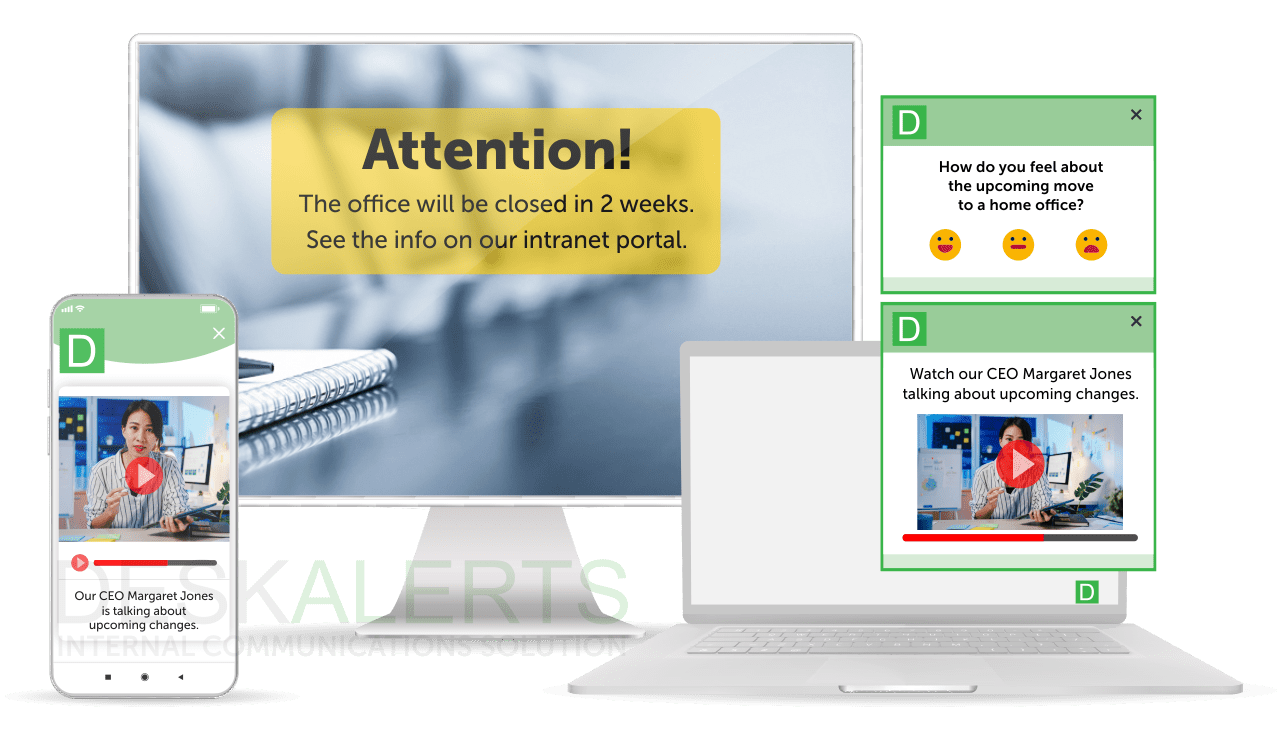
Change can be hard for everyone. Many people resist change because they don’t like to get out of their comfort zones. For those who are trying to implement changes, this can be difficult to navigate and counteract.
In this article, you'll learn how to create a strategy for communicating change in your company using our step-by-step guide. Bonus - a checklist for your communication plan and a calendar for your communication activities.
Table of contents
1. What is change management?
2. The importance of internal communication during change management
3. How to create a communication strategy for change management
4. Change management communication checklist
Change, however, is inevitable in life, and the business world is not immune. Having an effective change management communication strategy and processes in place can help your organization prevail when managing change in the workplace.
What is change management?
Change management is the term used in business to describe the strategic planning, processes and tools used to help deliver organizational change and help employees understand and adapt. Essentially it is the way that you guide employees through a transformation process to get to where you need them to be.
Undertaking change management processes will help to reduce the risk that the organizational change will be unsuccessful. Whenever you have a new project, system, process, initiative, or policy that can affect your business’s day-to-day operation, it's safe to say you need a change management process.
The importance of internal communication during change management
Whether you’re having an organizational restructure, introducing new software, or requiring your workforce to move to a new location, to ensure the change is a success, you need to have effective communication in your change management processes to get buy-in from your employees.
Unfortunately, a whopping 70% of organizational change initiatives fail, according to research by McKinsey.
And most of the common contributing factors that lead to change management failure can be attributed to ineffective communication.
A Robert Half survey of senior managers found that 65% believed communication was the most important thing for leading their teams through change.
Failure brings significant risks for businesses. If you don’t utilize internal communication during change management, the consequences could include:
- Wasted money and other resources
- Productivity inefficiencies
- Losing market share to your competitors
- Failure to meet new legislative regulations or requirements
- Reputational damage.
Change management communication is the information you deliver to your stakeholders to understand why a change is being made and how it will affect them. The essentials include:
- Communicating what the change will mean for the organization and why it is necessary
- Outlining the goals of the change
- Outlining how employees’ roles will be affected
- Providing a timeline of when the change will take place
- Providing help and assistance for employees
- Providing a way for employees to communicate with management and ask questions or give feedback.
Best practice in change management and communication is delivering messages in a timely manner that is clear and easy to understand, consistent, and relevant to the audience.
How to create a communication strategy for change management
 Having a change management communication strategy in place is essential for a successful change management initiative. A communication strategy in change management is a document that can be relied on to help work through the process of what information to send, when to send it, how to send it, and who should send it.
Having a change management communication strategy in place is essential for a successful change management initiative. A communication strategy in change management is a document that can be relied on to help work through the process of what information to send, when to send it, how to send it, and who should send it.
This step-by-step guide encompassing change management communication best practices will help you create an effective change communications plan.
1. Set out your communication objectives
When developing your internal communication strategy, you need clearly defined goals and objectives. This includes:
- What do you want to achieve?
- How do you plan to achieve it?
- Who will be responsible for it?
- How will you know it has been a success?
For example, if you are changing your company’s electronic record-keeping software, your goal may be to achieve a smooth transition from the old system to the new one. This may involve a staged change from the old system to the new one as records are migrated across, which will affect employees’ ability to create and save new records in the interim.
The responsibility of delivering internal communications using change management may lie with the internal communications department, in consultation with the IT department. And you may be able to tell it has been a success based on analytics and the types of calls that the help desk is getting.
2. Undertake a stakeholder analysis and define audiences
Before you communicate with your employees, you need to understand who they are, what they want, what they need, their concerns, what motivates them, and what they don’t like.
Also, keep in mind that the change you are planning might affect some employee cohorts more or differently.
An excellent way to do this is to create employee personas that are a representation of employees with different characteristics that can be used to help you determine the actions you will take - including what you say and how you deliver the messages.
From here, you can develop audience segments to communicate relevant information to the right people at the right time.
For example, suppose your organization is restructuring, and there will be lay-offs. In that case, you may have general messages for the entire company, and tailored messages for those employees who will be made redundant, and tailored messages for employees who will have their work changed due to losing some colleagues.
3. Develop your key messages
With your objectives and audience definitions in mind, it’s time to determine what it is you want to say. You will most likely have some overall general key messages as well as specific and tailored ones for different stakeholders and audience segments.
In developing your messages, you should ensure that you clearly outline:
- What the change is
- Who is going to be affected
- Why it is necessary
- Where and when the change will happen
- What the process will be to bring the change about.
Your key messages should:
- Be clear, concise and easy to understand. Avoid jargon.
- Be written in a warm, friendly, engaging tone.
- Be authentic.
- Be transparent.
- Explain what is happening and what it will mean for the organization/the staff member.
- Explain what actions the employee will need to take.
- Explain what help and assistance are available.
When communicating change in an organization, your messaging should also anticipate resistance. Resistance can come in many forms and is driven by emotions - it could include apathy, anger, grief, denial, resentment - particularly if the news is bad for some employees. It is very important that you acknowledge this, but are prepared in your response to deal with it.
4. Determine your delivery channels
 How are you going to deliver information to your employees? Different cohorts of employees have different communication preferences. Some would prefer not to receive email, while others prefer this traditional channel. While sending through multiple channels can also help with message retention.
How are you going to deliver information to your employees? Different cohorts of employees have different communication preferences. Some would prefer not to receive email, while others prefer this traditional channel. While sending through multiple channels can also help with message retention.
Consider using these change management communication tools and channels:
- Email - some people prefer to have information sent this way; however, for others it may not be as impactful as email overload can mean the information is missed or ignored.
- Face-to-face meetings - many employees prefer to receive information about substantial changes via face-to-face communication. This could be via a supervisor at a team meeting or town halls and other information seminars.
- Video content - many people would prefer to see a video than read words on a page. Short videos can be a useful tool to explain what your change is and why it is important.
- Dedicated intranet space - carve out an area on your intranet that is exclusive to the change process and associated information such as training tools, documents, fact sheets etc.
- Forums - a discussion area on your intranet where employees can talk about the change and give feedback and ask questions.
- Digital signage - create messages to be displayed on screens within your organization promoting the change to keep it in employees’ minds.
- Corporate screensavers are the same principle as digital signage, but the images are on employees’ computer screens to see it all day long.
To deliver your message on time, try new digital tools - like DeskAlerts, a change management software with a number of channels.
5. Develop resources and content
Create different resources for your employees to assist them with the change, again being mindful that you may have to create different content for different audience segments. The content also needs to be tailored to suit the delivery channels you are going to use.
This can include general notices, reminders, educational material, questions and answers, fact sheets, videos, live webinars, internal marketing material, and more.
It’s important that all of your resources keep a tight focus on the change and what it means for the employee. Resources should also be developed to allay fears and concerns for those who are resistant to the change.

6. Ensure you have leadership support
For change to be successfully embedded in an organization, it needs the support and commitment of leadership. Suppose employees perceive that leaders within the organization are not committed to or enthusiastic about the change. In that case, it’s unreasonable to expect them to follow suit - particularly if they are already resistant to the change.
From the top-down, all employees with leadership or management roles need to understand the importance of the change and be prepared to be ambassadors for the change, understanding what it is and why it is important for the organization.
Ensuring this cohort is briefed and prepared before you announce your change to the general employee population is imperative. If an announcement blindsides your management team members, they may react the same way as other employees (potentially reacting negatively), which can instantly undermine your efforts.
If they need to be equipped to have difficult conversations with their teams, you should also organize some appropriate training.
7. Deliver ongoing communication
For many reasons, it is unwise to communicate the change once and then do nothing else to follow up on that. Having a rolling campaign of messaging, particularly if you have a timeline when the change is going to take place, will help embed the idea of change within the organization and give people the opportunity to prepare to adapt.
Regular communication in the change management process also prevents rumors from taking hold and spreading - and if rumors are circulating, you can address them and head them off with the truth.
Having a change communication plan can help you build a successful narrative and help to distill the information for employees so they aren’t overwhelmed with too much information at once.
Internal communications planning calendar
Use this internal communications calendar to plan your change communications activities. Download for free!

8. Provide feedback mechanisms
When you’re implementing a change, it’s important to give employees a voice. Even if the change itself cannot be negotiated, your employees may have valuable insights into what the change will mean at the coal face in the company’s day-to-day operations. There may also be unforeseen consequences that arise during the change rollout.
Surveys are a useful tool to gather feedback at any stage of the change process and help you determine if your employees sufficiently understand what the change is and what is required of them. You can also use surveys to determine engagement and morale.
Other feedback mechanisms include face-to-face consultations, discussion forums on your intranet, town halls, Q&A sessions, and focus groups.
9. How will you evaluate your campaign?
It’s important to include mechanisms that can evaluate whether or not your change management internal communications efforts have been successful.
While you may be able to tell if the change has been successfully adopted or not based on observation, you also need to determine how effective your communications have been in getting to that point.
A mixture of quantitative and qualitative data can help to evaluate the campaign. Look at the analytics on the various resources you’ve created to see how often they were accessed and if there are any other interesting patterns. You can also survey employees or ask for feedback in other ways.
Change management communication plan checklist
 If you’re ready to begin your change management process, use this checklist to determine whether or not you have the best practice approach to communication and change management in place. It will also help you to fill in a change management communication plan template.
If you’re ready to begin your change management process, use this checklist to determine whether or not you have the best practice approach to communication and change management in place. It will also help you to fill in a change management communication plan template.
- Do you have an internal communications strategy?
- Do you understand your audience and stakeholder needs?
- Do you have leadership buy-in and sponsorship for the change?
- Are your leaders suitably prepared to respond to questions?
- Do your leaders need training in conducting difficult conversations?
- Do you think your leaders are convincing and authentic?
- Are you able to explain to the organization why the change is happening as well as the risks associated with not changing?
- Are you able to explain to individual employees what is “in it” for them to adopt the change?
- Do you have an approach in place to convince those who are showing the most resistance?
- Have you developed key messages?
- Have you developed frequently asked questions and answers?
- Have you identified the best tools and communication channels to use to deliver your messages?
- Have you developed a range of content to communicate your goals?
- Have you created a suite of educational material (if relevant) to train your employees in new processes/software/procedures?
- Do you have a campaign prepared where you will repeat messages across different channels over a period of time to ensure information retention?
- Do you have mechanisms in place to enable feedback and two-way consultation?
- Do you have a way of analyzing the success of your communication efforts?
***
Communication and change management go hand in hand. Your organizational change initiative’s success depends on your employees having a good understanding and acceptance of the need for change. Without having appropriate change management communication plans and processes in place, you will have a hard time convincing your employees to embrace the change.
Frequently asked questions
What is communication in change management?
Communication in change management refers to the information that is sent to employees about the change that is being introduced so that they can understand why it is needed and how and when the change will happen.
Why is communication important in change management?
Change management communication is important to help facilitate the successful implementation of a change initiative. It is necessary in order to help provide the information required to get employees to move from the present state to the future state that the change initiative is designed to deliver.
What is the difference between change management and communications?
Change management is a term used to describe the deployment or execution of a change in an organization. Communication is the act of sending information about the change initiative - it forms part of the change process, but is not the entire change process.
What is internal communication in change management?
Internal communication in change management generally involves delivering a series of planned messages about the change that is being implemented, using a range of different communication channels. The communication is designed to be informative and also needs to encourage employee ‘buy-in’ to ensure that the change is successful.
What are the requirements for an internal communications and change manager?
An internal communications and change management specialist should have the ability to engage internal stakeholders so that they understand the organization’s business priorities, operational objectives, and vision.
What is the role of communication in change management?
Communication plays an important role in the change management process. Communication for change management enables the exchange of feelings and ideas by the people within an organization, using various channels.

 Having a change management communication strategy in place is essential for a successful change management initiative. A communication strategy in change management is a document that can be relied on to help work through the process of what information to send, when to send it, how to send it, and who should send it.
Having a change management communication strategy in place is essential for a successful change management initiative. A communication strategy in change management is a document that can be relied on to help work through the process of what information to send, when to send it, how to send it, and who should send it. How are you going to deliver information to your employees? Different cohorts of employees have different communication preferences. Some would prefer not to receive email, while others prefer this traditional channel. While sending through multiple channels can also help with message retention.
How are you going to deliver information to your employees? Different cohorts of employees have different communication preferences. Some would prefer not to receive email, while others prefer this traditional channel. While sending through multiple channels can also help with message retention. 

 If you’re ready to begin your change management process, use this checklist to determine whether or not you have the best practice approach to
If you’re ready to begin your change management process, use this checklist to determine whether or not you have the best practice approach to 





